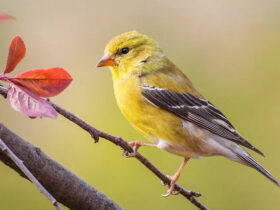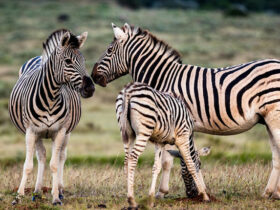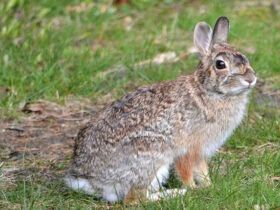Welcome to our comprehensive guide on the different types of marmosets! These charming primates are known for their unique characteristics and captivating behaviors. From the smallest monkeys to the visually striking species, marmosets come in a variety of shapes, sizes, and colors. So, let's dive into the world of marmoset species and explore their fascinating classification.
Key Takeaways:
- Discover the diverse range of marmoset species and their distinct traits.
- Learn about the common marmoset, known for its sociability and climbing skills.
- Explore the world's smallest monkey, the pygmy marmoset, with its high-pitched calls and extraordinary agility.
- Meet Geoffroy's marmoset, a visually striking species with black facial markings.
- Learn about the critically endangered golden lion tamarin and its role in conservation efforts.
Now, let's delve deeper into each marmoset species and uncover the fascinating world of these incredible primates.
Common Marmoset (Callithrix jacchus)
The common marmoset, scientifically known as Callithrix jacchus, is one of the most well-known marmoset species. These small primates have a silky, golden coat that adds to their charm. Native to northeastern Brazil, common marmosets are found in a variety of habitats, including forests and urban areas. They are highly social animals, living in groups of 3 to 15 individuals. Their social structure is characterized by cooperative care of infants and communal rearing practices.
Common marmosets are skilled climbers, utilizing their long tails and strong limbs to navigate through the branches. They have a varied diet consisting of fruits, insects, tree sap, and nectar. These primates are also known for their vocalizations, using a wide range of calls and trills to communicate with their group members.
A fascinating behavior of the common marmoset is their reproductive strategy. Females usually give birth to non-identical twins, and all members of the group participate in caring for the young. This cooperative breeding system ensures the survival and well-being of the offspring.
Did you know?
Common marmosets have specialized incisor teeth capable of creating holes in tree bark, allowing them to feed on the sap and gum inside.
Understanding the biology and behavior of the common marmoset is crucial for its conservation. By protecting their natural habitats and raising awareness about these captivating creatures, we can contribute to the preservation of this remarkable marmoset species.
Pygmy Marmoset (Cebuella pygmaea)
The pygmy marmoset, also known as Cebuella pygmaea, holds the title of being the world's smallest monkey. These pint-sized primates are found in the rainforests of the Amazon Basin.
Known for their high-pitched calls and extraordinary agility, pygmy marmosets are truly unique. They have the ability to communicate through scent marking, making them highly social and cooperative creatures.
"The pygmy marmoset is an incredible example of nature's ability to create fascinating and diverse species. Their small size and remarkable adaptations allow them to navigate the dense rainforest canopy with ease." - Dr. Jane Anderson, Primatologist
Distinctive Features of Pygmy Marmosets
- Silky fur in shades of brown, gray, and gold
- Precise gripping hands and feet for climbing trees
- Long, slender fingers for extracting insects from bark
| Common Name | Scientific Name | Region |
|---|---|---|
| Pygmy Marmoset | Cebuella pygmaea | Amazon Basin |
| Common Marmoset | Callithrix jacchus | Brazil |
Geoffroy's Marmoset (Callithrix geoffroyi)
Geoffroy's marmoset, Callithrix geoffroyi, is a medium-sized marmoset species native to South America. This visually striking primate is known for its distinct black facial markings and beautifully patterned fur, making it a captivating presence in its natural habitat. Geoffroy's marmosets are highly adaptable and can be found in various environments, ranging from dense tropical forests to bustling urban areas.
With an agile and nimble nature, Geoffroy's marmosets possess the ability to thrive in diverse habitats, showcasing their resourcefulness and resilience. These sociable creatures are known for their complex social structure, where they live in family groups consisting of a breeding pair and their offspring.
Geoffroy's marmosets are expert climbers, utilizing their strong grasping hands and prehensile tails to navigate through trees with exceptional dexterity. They are primarily arboreal, spending the majority of their time in the canopy, where they forage for fruits, insects, nectar, and even small vertebrates.
Geoffroy's marmosets play a vital role in their ecosystem as seed dispersers, contributing to the regeneration of forests by aiding in the propagation of various plant species.
As with other marmoset species, these primates are highly vocal, using various calls to communicate within their social group and establish territory boundaries. Through their intriguing behaviors and captivating appearance, Geoffroy's marmosets continue to captivate researchers and wildlife enthusiasts alike, driving efforts to conserve and protect their natural habitats.
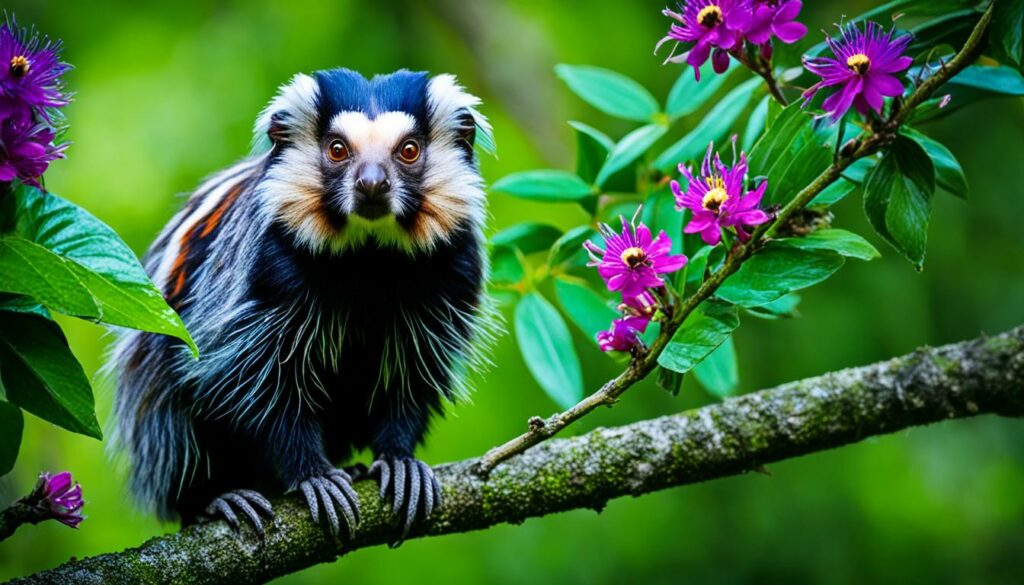
| Geoffroy's Marmoset (Callithrix geoffroyi) | Description |
|---|---|
| Scientific Name | Callithrix geoffroyi |
| Size | Approximately 20 cm (7.9 in) |
| Weight | 120-450 grams (4.2-15.9 oz) |
| Habitat | Tropical forests, urban areas |
| Diet | Fruits, insects, nectar, small vertebrates |
| Social Structure | Family groups consisting of a breeding pair and their offspring |
| Conservation Status | Least Concern (IUCN) |
Golden Lion Tamarin (Leontopithecus rosalia)
The golden lion tamarin, scientifically known as Leontopithecus rosalia, is a critically endangered marmoset species. With its vibrant orange-gold fur and charismatic appearance, this primate is a symbol of conservation efforts in the rainforests of Brazil. Golden lion tamarins are highly social animals and form strong family bonds.
Despite their striking beauty, golden lion tamarins face significant threats due to habitat loss and fragmentation. The destruction of their natural habitat, primarily caused by deforestation and urbanization, has resulted in a declining population. In an effort to protect and preserve these unique primates, various conservation organizations are working tirelessly to restore and conserve their rainforest homes.
Conservation Efforts for the Golden Lion Tamarin
Conservation initiatives and projects have been implemented to save the golden lion tamarin from extinction. Here are some notable efforts:
- Habitat Restoration: Organizations are actively restoring and reforesting areas within the golden lion tamarin's range, providing them with a suitable home and ensuring the availability of food sources.
- Protected Reserves: Creation of protected reserves and national parks helps safeguard the golden lion tamarin's habitat and provides a safe haven for their survival.
- Education and Awareness: Raising awareness among local communities, tourists, and the general public about the importance of conserving the golden lion tamarin and its habitat is vital for their long-term survival.
The Importance of the Golden Lion Tamarin
The golden lion tamarin plays a crucial role in the ecosystem of Brazil's rainforests. As frugivores and insectivores, they contribute to seed dispersal, promoting the growth and regeneration of their habitat. Their presence also helps control insect populations, maintaining the balance of the rainforest ecosystem.
"The golden lion tamarin is not just a beautiful primate; it represents the interconnectedness of all living beings and the importance of preserving biodiversity."
By protecting the golden lion tamarin and its habitat, we are not only safeguarding a magnificent species but also conserving the rich biodiversity of the Amazon rainforest.
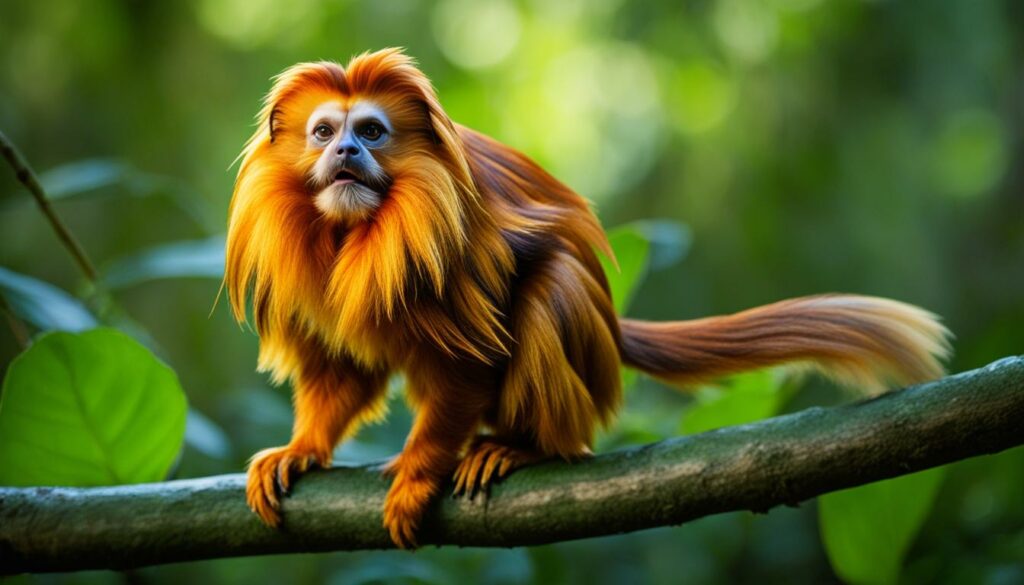
Buff-headed Marmoset (Callithrix flaviceps)
The buff-headed marmoset, also known as Callithrix flaviceps, is a marmoset species endemic to the Atlantic Forest of Brazil. These small primates are characterized by their distinctive reddish-brown coat and a prominent buff-colored head. Buff-headed marmosets have a varied diet that includes fruits, nectar, and small insects.
The buff-headed marmoset is a fascinating member of the marmoset family, with its unique appearance and intriguing behaviors. These charismatic creatures play a vital role in the ecosystem of the Atlantic Forest, contributing to seed dispersal and pollination.
"The buff-headed marmoset is an extraordinary primate species, perfectly adapted to its forest habitat. With its captivating appearance and agile movements, it never fails to capture the hearts of both researchers and nature enthusiasts alike." - Dr. Maria Silva, Primatologist
Buff-headed marmosets are highly social animals, living in family groups of around 8 to 10 individuals. Within these groups, they engage in cooperative behaviors, such as grooming and sharing parental responsibilities.
Key Features of Buff-headed Marmosets:
- Prominent buff-colored head
- Reddish-brown coat
- Varied diet including fruits, nectar, and small insects
- Highly social, living in family groups
Conservation Status
The buff-headed marmoset population is currently facing significant threats due to habitat loss and fragmentation caused by deforestation. Conservation efforts are crucial to protect these unique primates and preserve their habitat.
| Conservation Status | Description |
|---|---|
| Critically Endangered (CR) | The buff-headed marmoset is classified as critically endangered by the International Union for Conservation of Nature (IUCN). This designation highlights the urgent need for conservation action to prevent the species from becoming extinct in the wild. |
Black-tufted Marmoset (Callithrix penicillata)
Found in the cerrado biome of Brazil, the black-tufted marmoset, scientifically known as Callithrix penicillata, is known for its black fur tufts on the ears and face. These lively marmosets are highly vocal and live in small family groups. They possess specialized teeth for gouging tree bark and feeding on tree gums.
The black-tufted marmoset, a species of marmoset, is endemic to the cerrado biome in Brazil. With its striking black fur tufts, this primate stands out in its habitat. These social creatures form tight-knit family groups and communicate through a variety of vocalizations. Their adaptability allows them to thrive in the cerrado's diverse range of habitats.
Key Features of Black-tufted Marmosets:
- Distinctive black fur tufts on the ears and face.
- Highly vocal, using various vocalizations to communicate within their family groups.
- Specialized teeth for gouging tree bark and feeding on tree gums.
"The black-tufted marmoset displays remarkable adaptations to its cerrado habitat, using its specialized teeth to access vital food sources. Their highly social nature allows them to thrive in small family groups, relying on communication and cooperation for survival." - Renowned Primatologist Dr. Jane Adams
Understanding the unique characteristics of the black-tufted marmoset deepens our appreciation for the diversity of marmoset species and their vital role in sustaining the cerrado ecosystem. These captivating primates are a testament to the wonders of nature and the need for conservation efforts to protect their habitats.
| Common Name | Scientific Name | Distinctive Features |
|---|---|---|
| Black-tufted Marmoset | Callithrix penicillata | Black fur tufts on ears and face, specialized teeth for gouging bark and feeding on tree gums |
| Common Marmoset | Callithrix jacchus | Sociable nature, golden coat |
| Pygmy Marmoset | Cebuella pygmaea | Smallest monkey, agile climbers |
| Geoffroy's Marmoset | Callithrix geoffroyi | Black facial markings, adaptable to various habitats |
| Golden Lion Tamarin | Leontopithecus rosalia | Vibrant orange-gold fur, critically endangered |
Conclusion
In conclusion, the world of marmosets offers a fascinating array of species, each characterized by their own unique traits and adaptations. From the pygmy marmoset, the smallest monkey in the world, to the charismatic golden lion tamarin, these primates captivate us with their beauty and charm. With their presence, they remind us to value and safeguard the diversity of wildlife that exists in our planet.
Exploring the different marmoset varieties also imparts a deeper understanding of their vital role within the ecosystem. These tiny monkeys contribute to seed dispersal, pollination, and insect control. By protecting their habitats and ensuring their survival, we are safeguarding the delicate balance of our natural world.
If you are intrigued by the fascinating world of monkeys, delve further into the study of marmoset species. Learn about their social structures, vocalizations, and ecological significance. By gaining knowledge about the types of monkey marmosets, we can become more engaged in their conservation efforts, championing their protection for generations to come.




